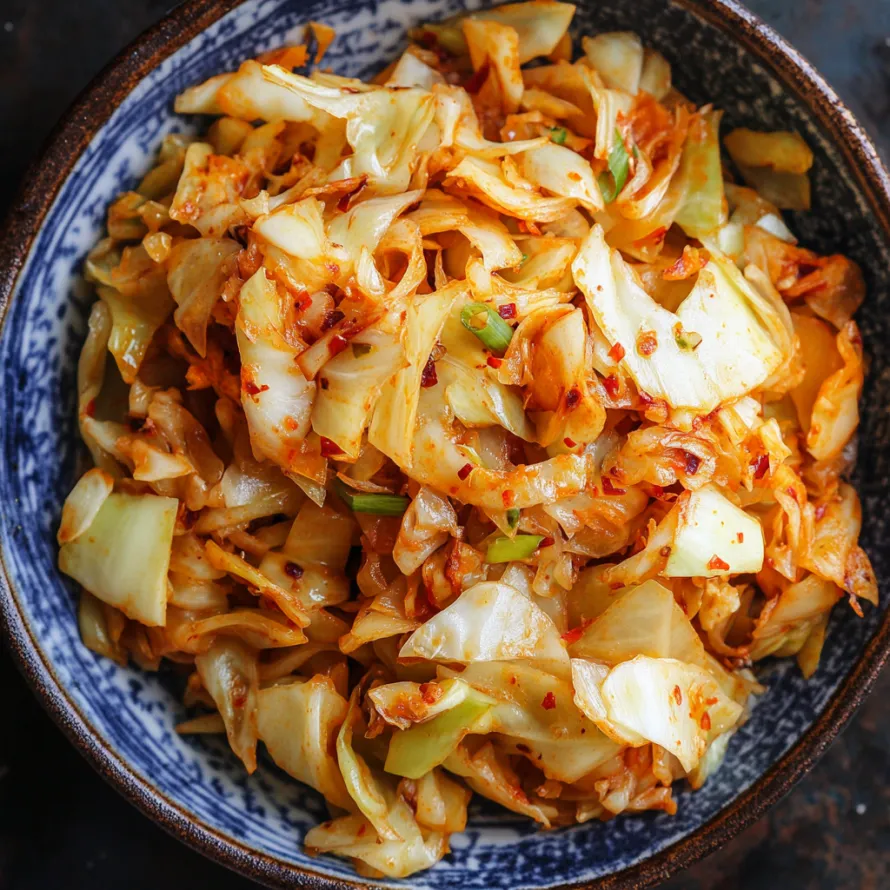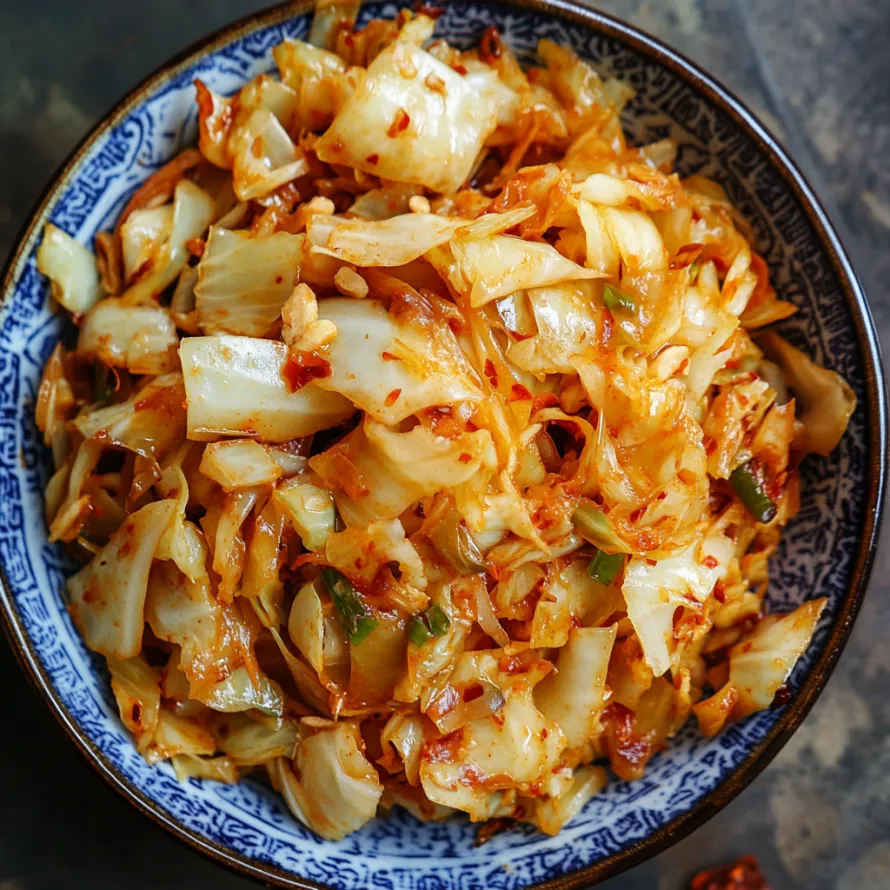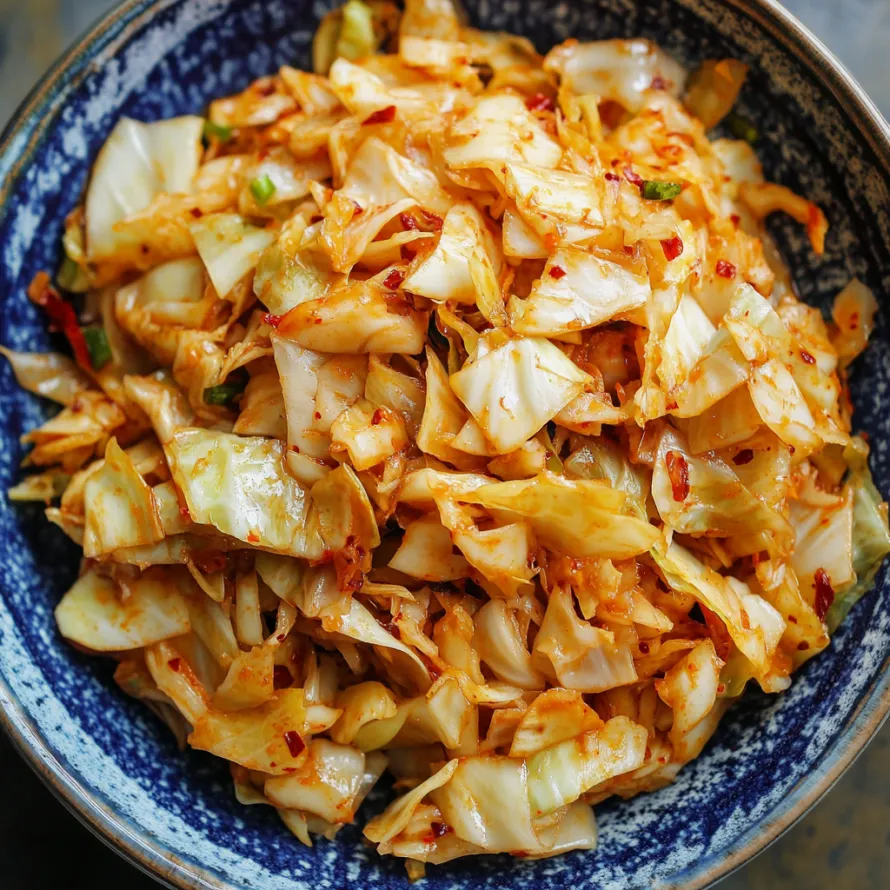 Pin it
Pin it
Tender savory cabbage transforms into a flavor-packed delight in mere minutes with this spicy cabbage recipe. The remarkable balance of heat and umami creates a perfect side dish that complements both protein-centered meals and grain-based dishes, while still standing strong on its own. The vibrant flavors develop quickly, making this dish an ideal solution for weeknight dinners when time feels scarce but you refuse to compromise on taste or nutrition.
I first made this recipe during a particularly busy week when I needed something quick yet satisfying. The transformation of humble cabbage into this savory, slightly spicy dish genuinely surprised me. Even my vegetable-reluctant family members requested seconds, which speaks volumes about its appeal.
Essential Ingredients Selection
- Cabbage: Select a green cabbage with tightly packed leaves and substantial weight for its size. This indicates freshness and higher water content, resulting in better texture when cooked. Avoid specimens with browning edges or soft spots.
- Tamari Sauce: This gluten-free alternative to traditional soy sauce provides a rich umami foundation. Look for varieties without added preservatives for the cleanest flavor profile. The natural fermentation process creates a complex taste that elevates the entire dish.
- Hot Paprika: Choose a vibrant red powder with noticeable aroma. Quality paprika should smell sweet yet spicy. Store in a cool, dark place to preserve its essential oils and vivid color. The freshness significantly impacts the final flavor intensity.
- Garlic: Fresh cloves with firm texture yield the most potent flavor. Avoid pre-minced options as they often lack the aromatic compounds that make fresh garlic so impactful. The sulfur compounds in garlic not only enhance taste but also provide numerous health benefits.
Creating Perfect Spicy Cabbage
- Begin With Preparation:
- Remove damaged outer leaves from your cabbage and thoroughly rinse under cool water. Slice cabbage into thin, consistent strips about ¼ inch wide, being careful to discard the tough core section completely.
- Heat Development:
- Pour high-quality olive oil into a large skillet over medium-high heat until it shimmers slightly. Add cabbage and hot paprika immediately, stirring consistently to ensure even coating and prevent burning. The cabbage should begin to soften and slightly wilt after approximately 3-4 minutes.
- Flavor Integration:
- Introduce tamari sauce, optional chili flakes for additional heat, and freshly minced garlic to the pan. Combine thoroughly with the cabbage mixture and continue cooking for another 2-3 minutes. The cabbage should maintain some crispness while absorbing the complex flavors from the sauce and spices.
- Taste Adjustment:
- Remove a small portion and taste for seasoning balance. Add additional tamari sauce if more umami flavor is desired, or a pinch of salt if needed for overall enhancement. Remember that flavors will continue developing even after cooking.
- Final Presentation:
- Transfer to a serving dish immediately to prevent overcooking from residual heat in the pan. The cabbage should appear vibrantly colored with a glossy finish from the tamari and olive oil.

I particularly appreciate the garlic in this recipe. My grandmother always emphasized garlic's importance in cooking, claiming it was nature's medicine cabinet. She would incorporate it into nearly every savory dish, and this spicy cabbage recipe reminds me of her wisdom. The aroma of garlic hitting the hot pan instantly transports me to her kitchen.
Outstanding Pairing Suggestions
This vibrant spicy cabbage creates magnificent meal combinations when served alongside proteins that complement its flavor profile. Consider serving with slow-roasted pork shoulder where the rich, fatty meat contrasts beautifully with the slight acidity and heat of the cabbage. For plant-based options, pan-seared tofu with a simple glaze provides textural contrast while allowing both components to shine independently. When serving with grains, consider a nutty brown rice or ancient grain mixture that adds additional nutritional benefits and satisfying texture.
Creative Recipe Adaptations
Transform this versatile recipe by incorporating regional flavor profiles that completely change its character while maintaining the cooking technique. Asian-inspired versions might include fresh ginger, a splash of rice vinegar, and toasted sesame oil finished with green onions. Mediterranean variations work beautifully with the addition of capers, lemon zest, and fresh herbs like oregano or thyme. For those avoiding sodium, consider substituting coconut aminos for the tamari and adding nutritional yeast for umami depth without additional salt content.
Proper Storage Instructions
Preserve leftover spicy cabbage properly by allowing it to cool completely before transferring to airtight glass containers. Glass prevents staining and odor absorption common with plastic storage options. When refrigerated promptly, this dish maintains quality for up to three days, with flavors often developing further during storage. For reheating, use gentle heat in a covered skillet with a tablespoon of water added to restore moisture. Microwave reheating works in 30-second intervals, stirring between each to ensure even warming without overcooking.

Recipe FAQs
- → Can I use regular soy sauce instead of tamari?
- Yes, you can substitute regular soy sauce if you don't need the dish to be gluten-free. Tamari provides a similar flavor but without wheat.
- → What type of cabbage works best for this recipe?
- Green cabbage is ideal, but you can also use napa cabbage or savoy cabbage. Each will give a slightly different texture and flavor to the final dish.
- → How do I store leftover spicy cabbage?
- Store leftover cabbage in an airtight container in the refrigerator for up to 3 days. Reheat gently in a pan or microwave until just warmed through.
- → Can I make this recipe less spicy?
- Absolutely! Reduce or omit the hot paprika and chili flakes according to your preference. You can add a touch of regular paprika for color without the heat.
- → What main dishes pair well with this spicy cabbage?
- This cabbage works great with grilled tofu, rice dishes, roasted chicken, or even as a topping for grain bowls. Its bold flavor complements simpler main dishes particularly well.
